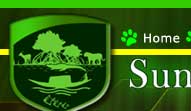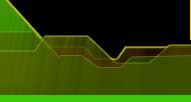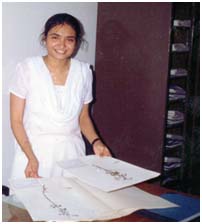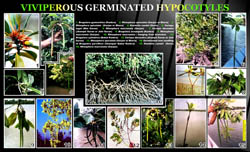|
|
 |
Sundarban Biosphere Resource Information Centre |
|
|
This part of the Information Centre provides a unique opportunity to get an overview of the floral diversity of Sundarban. The collections have been made from different areas of Sundarban (both North and South 24-Parganas) and are arranged systematically, starting from the lower groups of plants to the higher groups of angiosperms.
|
| Lower Plant Group : |
 |
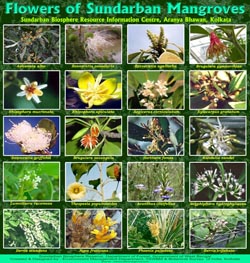
|
 The simplest fascinating group of primitive plants, commonly called Mushrooms/ Fungi have been collected, preserved scientifically and displayed in specimen jars. Fructifications of well-known species found in Sundarban have been also displayed. The simplest fascinating group of primitive plants, commonly called Mushrooms/ Fungi have been collected, preserved scientifically and displayed in specimen jars. Fructifications of well-known species found in Sundarban have been also displayed.
 Through the specimen jars displaying the Algal flora, one gets the opportunity to observe closely the richness of these chlorophyllous plants dominating the tidal creeks and muddy banks of Sundarban. Besides, algal flora inhabiting the pneumatophores of major mangroves has also been kept for viewing. Through the specimen jars displaying the Algal flora, one gets the opportunity to observe closely the richness of these chlorophyllous plants dominating the tidal creeks and muddy banks of Sundarban. Besides, algal flora inhabiting the pneumatophores of major mangroves has also been kept for viewing.
 The self-supporting combination of algae and fungi, forming what is known as ' Lichen ', exists in varied forms on mangrove barks of Sundarban. One can view these interesting formations through the display of such collections. The self-supporting combination of algae and fungi, forming what is known as ' Lichen ', exists in varied forms on mangrove barks of Sundarban. One can view these interesting formations through the display of such collections.
|
Higher Plant Group: |
 |
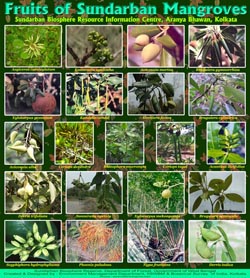
|
Sundarban holds the largest chunk of Mangrove forests. The unique mangrove vegetation has always been a subject of curiosity and inquisitiveness to any person. To satisfy the visitor's curiosity, one can examine the following;
 Pneumatophores , the characteristic breathing roots of well-known mangroves like Sundari, Baine, Keora . Pneumatophores , the characteristic breathing roots of well-known mangroves like Sundari, Baine, Keora .
 Dried Fruits and Seeds of some major mangroves and mangrove associates, whose benefits we enjoy without even knowing their existence in nature. Dried Fruits and Seeds of some major mangroves and mangrove associates, whose benefits we enjoy without even knowing their existence in nature.
 Well preserved germinating seedlings of some mangroves like Sundari, Baine, Garjan and Kankra, noted for its viviparous germination- a mangrove adaptation, are an added interest. Well preserved germinating seedlings of some mangroves like Sundari, Baine, Garjan and Kankra, noted for its viviparous germination- a mangrove adaptation, are an added interest.
|
Herbarium : |
 |
|
 The common, endangered and rare mangrove, mangrove associates and non-mangrove floral specimens have been dried and preserved scientifically in the Herbarium. The common, endangered and rare mangrove, mangrove associates and non-mangrove floral specimens have been dried and preserved scientifically in the Herbarium.
 This includes the Angiosperms , Monocots and Dicots as well as the variety of Ferns , representing the Pteridophytic Flora of Sundarban. This includes the Angiosperms , Monocots and Dicots as well as the variety of Ferns , representing the Pteridophytic Flora of Sundarban.
 By studying the Herbarium sheets , one is informed about the morphological features, ecological notes, including the importance and uses of the respective plants. By studying the Herbarium sheets , one is informed about the morphological features, ecological notes, including the importance and uses of the respective plants.
 The Angiosperm specimens have been arranged following the Bentham & Hooker's System of Classification for convenience in consultation. The Angiosperm specimens have been arranged following the Bentham & Hooker's System of Classification for convenience in consultation.
|
Mini Mangrove Park : |
 |
|
Why not experience the mangrove vegetation without actually been to Sundarban. Here one can view a few major mangrove plants in living condition along with dried fruits of each of them.
|
|
| |
|
|
|
